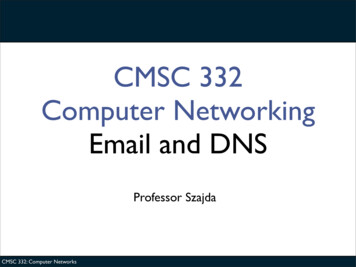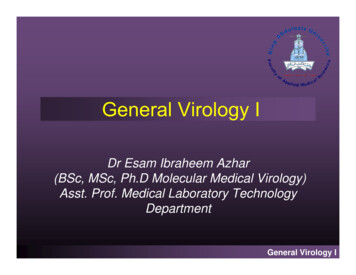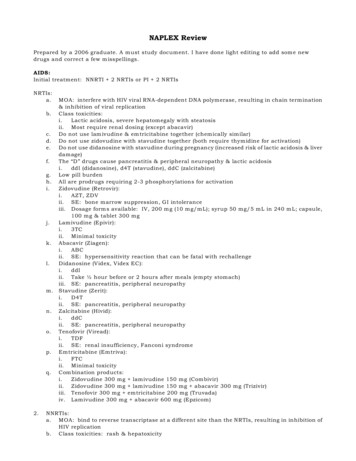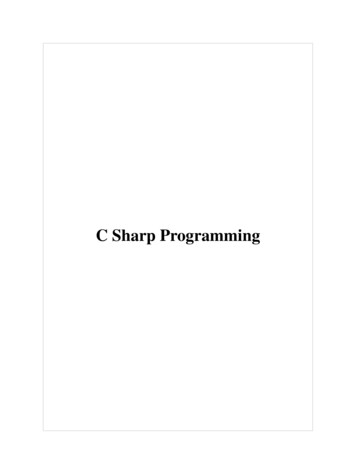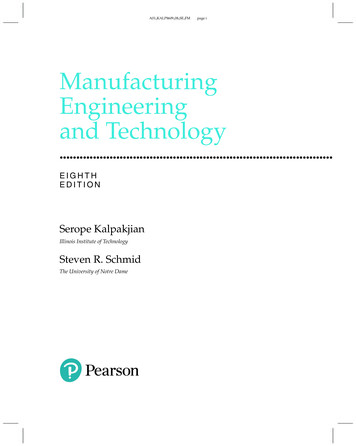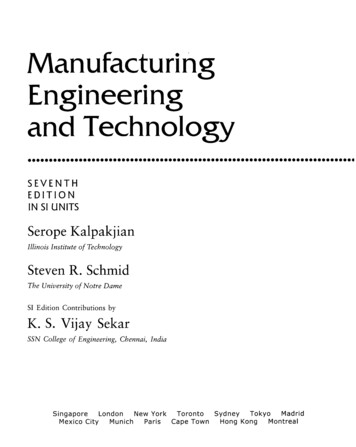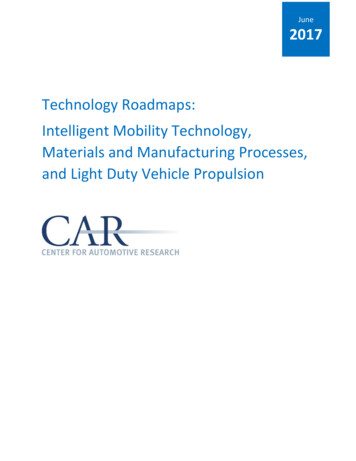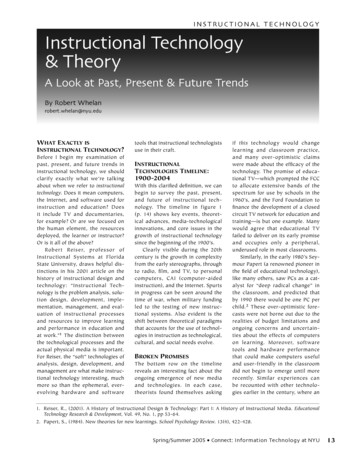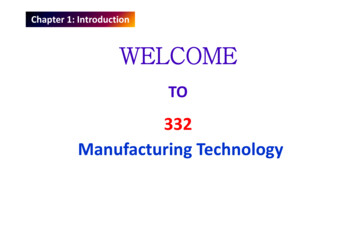
Transcription
Chapter 1: IntroductionWELCOMETO332Manufacturing Technology
Chapter 1: IntroductionProfessor Usama A.A KhashabaDepartment of Production Engineering &Mechanical Systems DesignKing Abdul Aziz Universityhttp://www.kau.edu.sa/CVEn.aspx?Site ID 0056848&Lng ENghttp://www.zu.edu.eg/users/khashabu
Chapter 1: IntroductionCHAPTER 1.1INTRODUCTIONTOOManufacturing Technology
Chapter 1: IntroductionText Book¾ Fundamentals of Modern Manufacturing: Materials,Processes, and Systems, Mikell P. Groover, forthEdition, 2010 John Wiley & Sons Inc.¾ Manufacturing Engineering and Technology, SeropeKalpakjian,a pa j a , SSixtht Edition,d t o , 2010,0 0, Prenticee t ce Hall.a¾Lecture Notes
Chapter 1: IntroductionRegulargLaboratoryy1) Casting2) Bulk Metal Forming3) Sheet metal processes4) WeldingW ldi processes5) Heat treatment
Chapter 1: IntroductionCOURSE ASSESSMENT GRADING Homework and AttendanceMid Term ExamLabFinal Exam10302040
Chapter 1: IntroductionWHAT IS MANUFACTURING ?Inspect various objects around you your pen, lamp, calculator,telephone,l hchair,h i andd lightli h fixtures.fiY willYouill soon realizeli thathall these objects had a different shape at one time. You couldnot find them in nature as they appear in your room.room They havebeen transformed from various raw materials and assembledinto the shapesp that yyou now see.
Manufacturing TechnologyManufacturing is the process of converting rawmaterials into products.productsTechnology can be defined as the application ofscience to pprovide societyy and its members with thosethings that are needed or desired. Technology affectsour dailyy lives,, directlyy and indirectly,y, in manyy ways.y
SYLLABUS Casting processes (solidification and melting, furnaces,expendabled bl andd permanentt moldld casting).ti ) Bulk deformation processes (hot and cold formingprocesses, workability and limits of forming) Sheet metal processes (formability of sheets and sheetforming processes, processing of polymers). Metal powders and ceramics Welding processes. Heat treatment of metalsmetals. Principles of metal cutting (machining processes, typesof chips,chips process sheet)sheet).
Chapter 1: IntroductionManufacturing includes three main stages:1. The design of the product2. The selection of raw materials3 The sequence of processes through which the3.product will he manufactured.
Components inProductsSingle component(nail bolt(nail,bolt, forkfork, coatkey, etc.)Multi-component(ball point pens,automobiles washingautomobiles,machines, etc.) All components aremanufactured. Manufacturing means,“Made by Hand”. جزازة العشب الدوارة
Example of Assembled ProductsThe first Incandescent lamp was made by T.A. Edison (1847-1931) in New Jersey and wasfirst lit in 1879.
Manufacture of Light BulbsTungsteng2200-3000 oCFigure I.3a Components of a commonIncandescent light bulb.bulbSource: Courtesy of General Electric Company.Figure I.3b Manufacturing steps inmaking an incandescent light bulb.Source: Courtesy of General ElectricCompany.
Materials in an Automotive EngineFiFigureII.11 SSectionti off an automotivetti enginei - theth DDuratect V-6V 6 - showingh i variousicomponents and the materials used in making them.(Source: Courtesy of Ford Motor Company. Illustration by David Kimball.)
Materials Selection for Paper ClipsQuestions for consideration: What material properties arerequired? What manufacturing attributes arerequired? WWouldld theth materialt i l andd processingistrategy change if the desiredquantity was 10,000 vs. 1 million perday?Figure I.2 Examples of the wide variety of materials and geometries for paper clips.
Product Design ProcessFigure I.3Depending on the complexityof the product and the type ofmaterials used, the time spanbetween the original conceptand the marketing of theproduct may range from a fewmonthsth tto many years.Various steps involved in design andmanufacturing a product.
Redesign of PartsFigure I.4 Redesign of parts to facilitate assembly.Source: Reprinted from G. Boothroyd and P. Dewhurst, Product Design for Assembly, 1989. Courtesy of Marcel Dekker, Inc.
Manufacturing Characteristics of Alloys
Baseball Bat CrossCross‐sectionssectionsFigure I.5 Cross-sections of baseballbats made of aluminum (top portion)and composite material (bottomportion).
Manufacturing Processes: CastingFigure I.6a Schematic illustrationof various casting processes
Manufacturing Processes: Forming and ShapingFigure I.6b Schematicillustration of various bulkdeformation processesExtrusion and drawing
Manufacturing Processes: Forming and ShapingFigure I.6c Schematic illustrationof various sheet metal formingprocesses
Manufacturing Processes: Forming and ShapingFigure I.6d Schematicillustration of variouspolymer processingmethods
Manufacturing Processes: JoiningFigure I.6f Schematicillustration of variousjoining processes
Manufacturing Processes: MachiningFigure 1.6e Schematicillustrations of various machiningand finishing processes.
Automated welding of automobilesFigure I.7 Automated spotwelding of automobile bodiesin a mass production line.Source: Courtesy of Ford Motor Company.
Application of CAD/CAM to make sunglasses moldFigure I.8 Machining a mold cavityfor making sunglasses.(a) Computer model of the sunglassas designed and viewed on themonitor.(b) Machine the die cavity using acomputer numerical-control millingmachine(c) Final product.Source: Courtesy of Mastercam/CNC Software, Inc.
Manufacturing Technology. Text Book Chapter 1: Introduction ¾Fundamentals of Modern Manufacturing: Materials, Processes, and Systems, Mikell P. Groover, forth Edition, 2010 John Wiley & Sons Inc. ¾Manufacturing Engineering and Technology, Serope Kaapa jalpakjian, SStixth Eddto ,ition, 200010, Preetcentice Hall. ¾Lecture Notes. Chapter 1: Introduction Reggyular Laboratory 1) Casting 2) Bulk .
